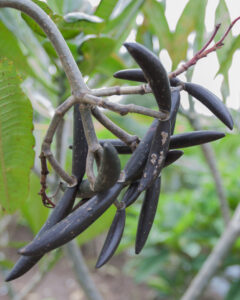Good quality seeds are essential to grow a strong and healthy plumeria. Healthy seeds can be bought from trusted sources or growers can produce their own seed pods. In that case, seed selection can be used to improve the quality of seedlings. Even if seeds are selected carefully, they still may carry diseases. In these cases seed treatment (e.g. hot water treatment or chemical seed treatment) could be used to further improve the quality of the seeds.

Small, shriveled and broken seeds contain less nutrition for the developing seedling. By removing these inferior seeds, the grower is able to grow stronger and healthier seedlings.
While seed selection is mainly aimed at obtaining healthier seeds, it can be used also to maintain and improve the quality of your plumeria seedlings. When growing plumeria from seed, there are always differences between plants. Plumeria Rubra seeds do not produce true to their parents. It’s rare to seed a seedling look like its parent, although it can happen, the seedling will never be exactly the same as a parent. Some plants may have characteristics that are more suitable than those of other plants. During the growing season, the grower should observe these differences and mark preferred plants with a ribbon or with a stick. When those plants produce seed pods, the seeds of these plants can be reserved for growing the next group of seedlings. In this way, the grower can slowly improve the quality of their seedlings.
The selection of these plumeria seeds may be based on characteristics such as the size of the plant, color of flower, blooming traits, etc. But selection can also be done to keep seeds of plumeria that suffered less attacks by insects or diseases.
In this way, the grower will select the best seeds to be kept apart for the next season. Still, just before starting the seeds, it is recommended to select once more to remove seeds that are too small, spotted, deformed, discolored, etc.
Selection of Parent or Parents
When thinking about choosing a pod parent you should take into consideration which characteristics you would like your new seedling to have:
- Flower: Color, Size, Keeping Quality
- Fragrance, etc.
- Tree: Growing Habit.
- Leaves: Color, Size, etc.
- Blooming: Quality, Size of Inflorescence, Number of flowers blooming at the same time, How long does it bloom, etc.
The goal is to get a spectacular plumeria seedling that has some of the characteristics you want in your new Plumeria.
To help you better understand why. If a seed pod has 40 seeds and the seeds can inherit genes from 7 generations back, you can understand why it is common for each of seeds from the same pod to have completely different genes and look nothing alike.
If Possible:
- Select a pod parent that is known to produce the characteristic you desire or at least a pod parent that has the characteristics you desire.
- Obtain seeds from trusted growers.
- Find out the history of the pod. i.e. What’s growing close to the pod, did they bloom at the same time. Was it cross pollinated (it will be very rare to find seeds for sale that has been cross pollinated), manually pollinated by human or pollinated by nature (could be self pollinated or by insects)?
- Obtain all the seeds from a pod when possible.
- Select seeds from a healthy tree.
- Select seeds that are plump and look healthy.
A couple of general observations:
- Large seeds usually produce larger seedling and small seeds usually produce smaller plumeria.
- Dark colored seedling generally produce darker seedling then lighter colored seeds.
- When a seedling is dark in color, dark leaves and dark trunk, there is a better chance of getting a flower with nice color. But I have seen dark trunk and dark leaves on seedling that produced white flowers. The reverse is also true.
I feel the most important factor in pollination and seed selection is the selective of parents or at least the selection of the pod parent! Many years ago I planted about 15 seeds from Penang Peach, one seedling that bloomed in 2009 exceeded my expectations, we named it Camelot. It turned out to be a great seed producer and I’ve been planting seeds for Camelot every year. In 2013, I started experimenting with pollination and cross-pollinate. As a result, I got one seed pods that producing a total 38 seeds from Camelot. I planted them in 2014 and in 2016 some of the seedlings started to bloom and in 2017 more bloomed, so far I have 18 plus I consider to be keepers. Several stood out, one I named Merlin, because it is very similar to Camelot and Penang Peach. Now I hope to get seeds from Merlin in 2018 and cross to introduce a few more desirable characteristics.
I selected Penang Peach because of its variations in flower colors, fantastic blooming, compact grower and history of producing quality seedling. Some of the seedling from Penang Peach are: Camelot, Australia, Barry’s Orange, California Sunset, CS3, Della Nui, Dtaeng Mo, Elsie, George Brown, J105, Parameno, Pink Diamond, Pride of Nui, Purple Jack, Tropical Aurora, Wasitee and many more are believed to be seedling of Penang Peach.